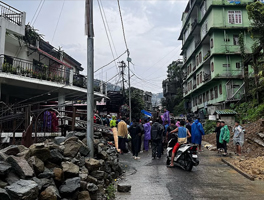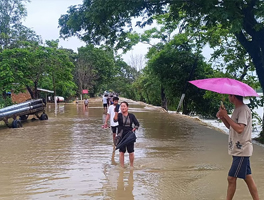 |
Dear readers,
Welcome to the Climate Weekly newsletter by the Centre for Science and Environment’s Climate Change programme and Down to Earth.
On June 4, the Centre for Science and Environment released its report “State of India’s Environment in Figures 2025”, providing a stark reality check on India’s progress on multiple environmental and development priorities. Using 48 indicators across four thematic areas, environment, agriculture, public health and human development, the report ranked all 36 states and Union Territories. Andhra Pradesh, Sikkim and Goa fare well in individual categories, but no state emerges as a consistent performer across the thematic areas.
Andhra Pradesh led in environmental management, but fared poorly in sewage treatment and river pollution control. Similarly, Sikkim topped the agriculture rankings but lagged in farmer welfare. Large populous states such as Uttar Pradesh, Maharashtra, Bihar and West Bengal—home to nearly half of India’s population—ranked poorly across all categories. 2024 was also India’s warmest year on record, with extreme weather events occurring on 88 per cent of the days—triggering 5.4 million internal displacements. Further, India’s greenhouse gas emissions reached its highest global share since 1970 at 7.8 per cent.
In energy news, a new report by the International Energy Agency (IEA) sheds light on global energy investments in 2025. Down to Earth’s Rohini Krishnamurthy writes that China has increased its share of global clean energy investments from a quarter to almost a third between 2015 and 2025, reaching $625 billion in 2025. India has increased its renewable energy investments from $13 billion in 2015 to $37 billion in 2025. Global clean energy investments are projected to reach $2.2 trillion in 2025, twice the investment in oil, natural gas, and coal combined. The report underscores that annual investments must be doubled to achieve a tripling of installed renewable capacity by 2030—agreed upon at COP28.
Finally, a study by the India Energy & Climate Center (IECC) at the University of California, Berkeley has revealed that India witnessed a dramatic 95 per cent drop in solar costs from over INR 200 per watt in 2010 to under INR 9 in 2024. The report suggests solar-plus-storage systems can deliver 24/7 electricity with over 95 per cent availability at under INR 6 per kiloWatt hour (kWh). The shift is caused by cheaper panels and technological advances in battery storage—and carries the potential to transform India’s clean energy sector.
|
|
 |
| |
 |
|
| |
 |
 |
| |
By - Upamanyu Das
Climate Change, CSE
|
| |
|
 |
|
|
| |
 |
|
| |
| EXTREME WEATHER TRACKER |
| |
Northeast Deluge 2025: Nearly 600 landslides in Mizoram; five dead, hundreds displaced amid unrelenting rains, 03 June 2025
|
 |
 |
|
|
| |
 |
|
| |
 |
 |
Northeast Deluge 2025: Over 500,000 people stare at homelessness in Assam due to floods caused by extreme rainfall, sudden release of dam waters, 03 June 2025
|
|
|
| |
 |
|
| |
|
|
| |
 |
|
| |
|
|
| |
|
|
| |
|
|
| |
 |
|
| |
|
|
| |
 |
|
| |
CLIMATE NEWS | SCIENCE| IMPACTS| POLITICS |
|
| |
 |
|
| |
|
|
| |
 |
|
| |
|
|
| |
 |
|
| |
|
|
| |
 |
|
| |
|
|
| |
 |
|
| |
|
|
| |
 |
|
| |
|
|
| |
 |
|
| |
|
|
| |
 |
|
| |
|
|
| |
 |
|
| |
|
|
| |
 |
|
| |
|
|
| |
 |
|
| |
|
|
| |
 |
|
| |
|
|
| |
 |
|
| |
|
|
| |
 |
|
| |
|
|
| |
 |
|
| |
|
|
| |
 |
|
| |
| Webinar |
|
Online Training Course |
| |
|
|
|
|
|
|
|
|
| |
|
|
| |
|
|
| |
|
|